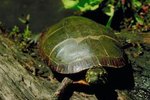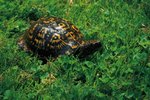
Turtles are well protected by their shells, but that does not mean they can brazenly sleep wherever they like. Depending on the species, habitat and size of a given turtle, it may sleep in a variety of places. In most cases, the turtle will choose a refuge that affords him some extra protection while he takes a nap.
Soil and Leaf Litter
Box turtles apparently find leaf litter to be a cozy place for a snooze. In a 1971 issue of “Copeia,” Richard A. Dolbeer detailed his observations of box turtle (Terrapene carolina) hibernating behavior in eastern Tennessee. In the course of his research, Dolbeer found that during the fall, box turtles were always buried in the leaf litter -- presumably asleep -- when they weren't active. Most often, the box turtles were buried deep enough so the tops of their shells were flush with the ground. In another study -- this one by Vincent J. Burke, et al., of the Savannah River Ecology Laboratory, published in a 1994 issue of “American Midland Naturalist” -- mud turtles (Kinosternon subrubrum) were observed leaving the water and digging egg chambers. The turtles then entered the holes, deposited their eggs and remained underground for several days before exiting the holes and returning to the water. Further analysis by researchers showed that the turtles dug their burrows during or after a rainstorm and stayed in the hole until the next rainstorm; presumably the rain softened the ground, facilitating easier entry and exit.
Burrows and Tree Stumps
In Dolbeer’s study, he found that box turtles greatly preferred deep burrows and holes to sleep in during the coldest days of winter. Most often, box turtles used decaying tree stump holes, but some species dug their own burrows. Gopher tortoises (Gopherus polyphemus) are perhaps the most remarkable tunnelers of all turtles, and their elaborate tunnels contain an entire ecosystem of 360 species, including the endangered indigo snake (Drymarchon couperii).
Dense Vegetation
Sometimes, when a burrow or hole isn’t available, a turtle will just crawl deep into dense vegetation for the night. Eastern box turtles (Terrapene carolina) sometimes use blackberry (Rubus sp.) tangles as a sleeping spot. This choice provides two benefits for the turtles: the sharp thorns of the bushes dissuade some predators, and blackberry is an important dietary staple for the turtles.
Mud
Most aquatic and some semi-aquatic turtles burrow into the mud to hibernate or sleep. Though turtles breathe oxygen, many species like soft-shell (Apalone sp.), sliders (Trachemys scripta ssp.) and snapping turtles (Chelydra serpentine) can absorb oxygen directly from the water. Some more terrestrial species, like African mud turtles (Pelusios subniger), will bury themselves in the mud to aestivate when their temporary pools dry up. These turtles will sleep there for up to six months as they wait for the next rainy season.
Underwater Structures
Turtles may wedge themselves into tight crevices in rock piles or submerged tree stumps for the night. Turtles may also use rock pilings, rip rap, dams and other man-made structures for sleeping. Very large turtles, like alligator snapping turtles (Machrochelys temminckii), have few natural predators and may not feel the need for protective structure; these animals may just sleep on the bottom of the pond.
Basking Platforms
Some aquatic turtles will sleep exposed on their basking spots. The turtles must feel safe to do so; as such, they're more likely to sleep on basking spots surrounded on all sides by deep water. Turtles basking on a tree stump within a few feet of the shore are likely to bask with one eye open so they can quickly dive to safety.
References
- Copeia: Winter Behavior of the Eastern Box Turtle, Terrapene Carolina, in Eastern Tennessee
- Herpetologica: Mortality in Hibernating Ornate Box Turtles, Terrapene Ornata
- Journal of Herpetology: Diet-Dependent Differences in Digestive Efficiency in Two Sympatric Species of Box Turtles, Terrapene Carolina and Terrapene Ornata
- Physiological Zoology: The Viability of Chrysemys Picta Submerged at Various Temperatures
- American Midland Naturalist: Prolonged Nesting Forays by Common Mud Turtles (Kinosternon Subrubrum)
- Zoology: Mechanisms of Homeostasis During Long-term Diving and Anoxia in Turtles
- Gopher Tortoise Services, Inc. : Why All the Concern About Gopher Tortoises?
- Arkive: East African Mud Turtle
Photo Credits
-
Thinkstock Images/Comstock/Getty Images



